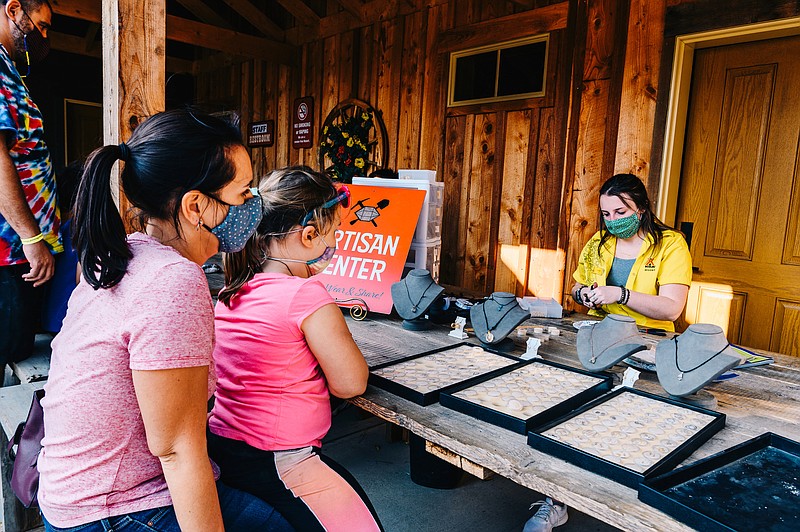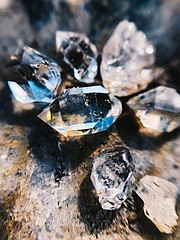Moonstones in Montana, amethyst and emeralds in North Carolina, garnet and quartz in upstate New York. At pay-to-dig mines around the United States, visitors can paw through piles of mine tailings to uncover crystals and gemstones on "finders, keepers" terms for as little as $10 a day.
At Herkimer Diamond Mines in central New York, home to an especially clear and unusually hard type of quartz crystal known as the Herkimer diamond, a $14 admission price includes a day of prospecting and the rental of a rock hammer. (Children under 4 mine for free.)
In a typical year, one-fifth of the mine's customers are international tourists, so when the coronavirus halted travel and delayed the start of this year's April-to-November digging season, mine proprietor Renée Scialdo Shevat worried about what the loss in revenue may do to the 40-year-old family business.
By late summer, she was more concerned with how to limit the crowds. Diggers of all ages and degrees of seriousness had begun arriving in droves. "These days, every day is like a Saturday," Shevat said in early September.
Even before the pandemic sent people searching for road trip destinations and outdoor adventure, interest in prospecting and rockhounding (or "fossicking," as it is called in Britain and Australia) was already ticking upward. That has prompted some mines that had long been closed, like the Ruggles Mine in Grafton, New Hampshire, toward new life.
From 1963 to 2016, Ruggles hosted tourists and hobbyists seeking mica, aquamarine, rose quartz and other treasures in its underground chutes and caverns. (It closed in 2016 when its owner, then 90, retired.) Late last year, New York City developers snatched it up with plans to reopen it as a tourist attraction, with major upgrades.
Mine owners aren't the only ones with bright prospects. Some entrepreneurs are finding ways to carve out new careers in gemstones, too.
For example, after having their jobs and schooling upended by the pandemic in the spring, Frank and Kyndall Stallings, 22 and 27, of Charleston, Missouri, pivoted to digging for crystals.
"It all started in February, when Frank took me to the diamond mine in Arkansas for Valentine's Day," Kyndall Stallings said of the couple's visit to a $10-a-day public mine called Crater of Diamonds State Park in Murfreesboro, Arkansas.
While they didn't bring home a diamond, they did find a tiny piece of quartz. The experience was a thrill of life-changing proportions. By mid-March, Frank Stallings' work as a financial adviser had slowed significantly, Kyndall Stallings' classes for a bachelor's degree in horticulture had gone remote, and a job she had recently been offered - data entry at a hospital - never started.
With their newfound time, the Stallingses were mining nearly every day.
By mid-April, the couple had sold everything they owned on Facebook, burned everything they couldn't sell in a bonfire, packed up their truck and hit the road to work as freelance crystal miners.
"Fifty dollars a day to dig, and if you dig really hard you find $2,000, $3,000, $5,000 worth of crystals," Frank Stallings said, referring to Ron Coleman Mining, a crystal mine in Arkansas where the couple recently unearthed a "once in a lifetime" 15-pound clear quartz point, which they later sold for $1,500.
While $5,000 days are extremely rare, the Stallingses do earn a living selling specimens of gold, amazonite, pyrite, quartz, fluorite, shark teeth and obsidian out of the back of their Toyota RAV4 and on eBay.
To keep overhead low, they are camping full time, but expect this "tent life" phase to be just a rite of passage. Kyndall Stallings recently emailed from a campsite on the Upper Peninsula in Michigan, where the couple were hunting iridescent yooperlite by UV flashlight at night. "We are just getting started and foresee huge success with this business we are building," she wrote.
MINER AMBITIONS
A dedicated rockhound may, in theory, make up to $10,000 a month selling his or her finds on the internet. A mineral or crystal that is hand-collected at a domestic, noncommercial site may fetch several times the price of one imported from a commercial mine abroad, especially in countries where the gemstone trade is known to finance conflict and genocide. Sellers can sometimes charge even more if they capture their finds on video (and hype them on social media).
One of the kingpins of this business model is Bryan Major, aka the Crystal Collector, a shaggy-haired prospector who posted his first crystal-digging video to YouTube nine years ago.
Video after video show him brandishing an amethyst cluster the size of his torso or an aquamarine crystal the length of his forearm - not only courting potential buyers, but also luring rockhounding newcomers with what they could achieve.
To make a career of digging crystals and gemstones, a nomadic life isn't mandatory: Patrick and Samantha Krug, 32 and 30, go rockhounding multiple times a week a stone's throw from their own backyard in Fonda, New York.
"There's nothing like birthing a crystal that has been in the dark for 500 million years, being the first one to bring it into the light, not knowing what you have until you get it out and clean," Patrick Krug said. He and his wife fell in love with digging Herkimer diamonds while in college. (The couple go by "Him & Herk" on Instagram.)
The clearer and cleaner edged they are, the more value Herkimer diamonds have, and good specimens are increasingly popular both for their use in healing rituals and in jewelry. (Meghan Markle wore Herkimer diamond rings, stud earrings and a bracelet to Princess Eugenie's wedding last October.)
Despite the Herkimer diamond's cachet, the Krugs haven't fully cashed in. They are keeping their operation small and holding onto most of what they find. "We're trying to collect every formation Herkimers make," Patrick Krug said. "If it speaks to us, we're going to keep it."
"Right now, we mainly only sell on social media," Samantha Krug added. "I'd like to have a stronger personal collection before really selling them."
CRYSTAL HARVEST
In recent years, crystals - once relegated to the New Age fringes - have formed the bedrock of a mainstream market. As celebrities including Katy Perry, Kylie Jenner, Kim Kardashian West and others espoused the healing properties of crystals and gemstones, the price of small specimens rose fivefold over the past decade. Between 2017 and 2019, U.S. demand doubled.
Some stars, like Gwyneth Paltrow and the former "Hills" stars Spencer Pratt and Heidi Montag, have spun the crystal craze into business opportunity. Pratt, in a recent interview, said the couple's home is filled with "at least 1,000" crystals. Montag had $27,000 worth of them placed at her bedside during the birth of the couple's first child. In 2018, they started a web store, Pratt Daddy, which peddled hundreds of healing gemstones per week for as much as $300 apiece.

